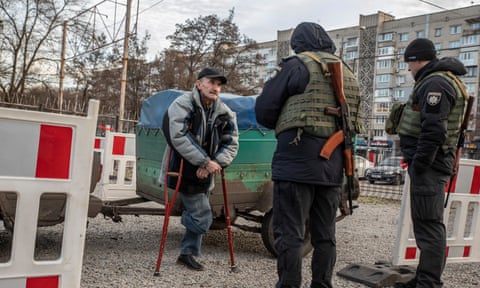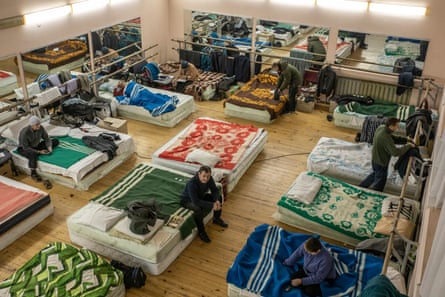Julian Borger

The people of Nova Kakhovka on the east bank of the Dnipro River had grown accustomed to constant shelling, but in recent days they have been hearing machine gun fire as the war draws closer to what could be its next major battlefield.
Despite predictions that the conflict would slow down in the winter months, civilians arriving in Zaporizhzhia through the last open crossing point on the frontlines say the fighting is escalating in southern Kherson region as Ukrainian forces seek to keep the Russians on the retreat towards Crimea and beyond.
“It has been machine guns lately, not artillery,” said Anna, a 78-year-old from Nova Khakovka after arriving at a police checkpoint in Zaporizhzhia. “The windows were shaking, the house was shaking. We were afraid that everything could collapse at any moment.”
“The fighting has become more intensive,” said Liudmyla, another woman from the town waiting for her papers to be checked at the Zaporizhzhia checkpoint. Like Anna and other new arrivals, she did not want to give her surname for fear of reprisals against relatives or friends left behind.
“There was machine gun fire right in the town park. We saw Russians running around the park with machine guns.”
There have been multiple reports of Ukrainian special forces raids across the Dnipro since the fall of Kherson city.
Liudmyla said the highway they travelled along, from Nova Kakhovka east towards the Russian stronghold in the city of Melitopol had been turned into a defensive line with concrete pyramids known as “dragon’s teeth” and trench networks.
Nova Kakovka is a particularly strategic point, a town of 70,000 people before the war, where Ukrainian and Russian forces now face each other across a narrow part of the Dnipro and a hydroelectric dam.
The town’s residents said the Russians had mined the 400-metre bridge running on top of the dam, with two trucks loaded with explosives parked along the span. The administrative offices of the adjacent hydroelectric plant had been turned into a bastion, bristling with weaponry. Civil servants working for the Russian occupation authorities abandoned the town last month.
Since Kherson city and the north-western part of the Kherson oblast fell to the Ukrainian counter-offensive on 11 November, the Russians have been setting up defensive lines in southern Kherson and Zaporizhzhia regions.
The retreating troops who arrived in Nova Kakhovka in the past few weeks have been nervous and aggressive. Residents who had stayed because they had elderly relatives who could not move or who had hoped that the town’s liberation would come quickly, decided they had no choice but to leave.
 The gym of the concert hall in Zaporizhzhia has been turned into a shelter for displaced people coming from the occupied territories. Photograph: Alessio Mamo/The Guardian
The gym of the concert hall in Zaporizhzhia has been turned into a shelter for displaced people coming from the occupied territories. Photograph: Alessio Mamo/The Guardian“They came to my house at 7 o’clock in the morning. There was an armoured car outside. They were rapping on the door telling me to open faster,” Anna said. “They said they were looking for ‘bandits’. They just looted the other houses. They were looting everything.”
The Russians suffered heavy losses in Nova Kakhovka in late July and early August when Ukraine rained down newly acquired US guided rockets on an army base on the banks of the Dnipro. In the aftermath, residents said they saw bodies of dead Russian soldiers stacked in army trucks, and that the stench in the town became unbearable from the corpses being burned in the woods.
“They had a dump behind the forest but they would just move the bodies there and burn them,” Anna said. “The smell was indescribable. They were burning the remains for a whole week. It wasn’t possible to be on the streets at night. It was impossible to open a door or window.”
Oksana, who left Nova Kakhovka in mid-September, said she saw piles of Russian dead after the Ukrainian rocket strikes.
“There was a sort of military ambulance. It was a covered truck but there were little openings in the covering and I saw them, the bodies, stacked one on top of each other,” she said.
“From that day for a week there was smoke,” Oksana said. “You would shut the doors and close the windows. And there was this stench that you can’t confuse with anything else.”
The witnesses did not see the bodies being cremated and their accounts could not be independently verified. But they echoed reports in November from the outskirts of Kherson city that the Russians had resorted to burning their dead at a municipal landfill.
 Cars coming from occupied territories are checked in a police station in Zaporizhzhia. Photograph: Alessio Mamo/The Guardian
Cars coming from occupied territories are checked in a police station in Zaporizhzhia. Photograph: Alessio Mamo/The GuardianThe last open crossing point for civilians along the southern front is near Vasylivka, a town on the Dnipro about 30 miles (50km) south of Zaporizhzhia. Up to 6,000 people used to cross each day before late September, when Russia declared the annexatieon of four Ukrainian regions, including Kherson and Zaporizhzhia and shelled a convoy of cars of civilians who had come to the Ukrainian side of the lines to collect relatives arriving from Russian-controlled territory.
Now the rate of arrivals is down to 300 a day, according to Oleksii Savytskyi, a municipal official overseeing a reception centre for the newly displaced.
“I think it is because they need to keep people as a human shield,” Savytskyi said. “If everyone just left, that would make the job for our military easier.”
Before the Ukrainians acquired US-made Himars multiple rocket launchers in July, Anna said the Russians in Nova Kakhovka felt unchallenged.
“They felt they were masters of the city,” she recalled. “They would go around drinking and said: ‘This is like a resort to us. We are going to move here.’”
After the missile strikes wiped out their riverbank camp, however, they withdrew their heavy weapons into the forest, and started digging trenches. After the fall of Kherson city, the size of the garrison increased dramatically, and in recent days it has become a lot more nervous.
“There’s a lot of them and they’re panicking because the Ukraine armed forces are too close,” Oksana said. “There is a feeling they can storm the city at any moment.”
No comments:
Post a Comment